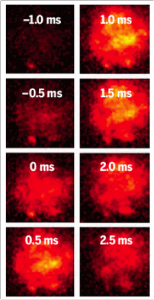The Ultimate Neuronal Activity Sensor is Here

I made my PhD in the field of neuroscience, more specifically in neuroimaging. But contrary to what the term might suggest to many we didn’t focus on the brain as a whole but on the activity responses of single neurons. To be able to characterize its activity patterns we made use of 2-photon microscopes, a state of the art type of light microscopy that allows for deep penetration of the light beam into alive tissue, in combination with fluorescent calcium-based sensors. With this technique we could see neurons in action. However, these type of sensors have slow kinetics which makes it hard to quantify the extent and duration of a cell’s activation under a certain stimulus.
In our field a voltage sensor with submillisecond precision was the most expected technical development. And now, it is here.

Source: An imaging experimental series show voltage spreading through a fruitfly neuron over just about 4 milliseconds, a hundred times faster than the blink of an eye. The technology can detect impulses as fleeting as 0.2 millisecond — 2000 times faster than a blink. Credit: Yiyang Gong, Duke University.
In an article published recently in Science scientists from the Universities of Standford and Duke report the development of the new tool. The lead author in the paper, Yiyang Gong, explained the approach to Science News. They decided to combine two proteins: one that would sense the quick neuronal change in voltage potential after activation with another that would provide the visual output necessary for imaging. The first protein is a fungus-derived protein that responds five to six times more quickly to changes in voltage than the one used in their previous model, whereas the fluorescent marker was engineered by Nathan Shaner and colleagues at the Scintillion Institute. This marker is bright enough that it can be detected by the microscopes normally used to image the brain in action without actually frying it to get any fluorescence as it was the case with the old generations of voltage sensors. The combination allows for the observation of spikes of electrical activity under the microscope with a temporal resolution of about 0.2 milliseconds. A resolution that so far was impossible to achieve with the old calcium sensors.
Another great advantage of this new tool is that it can be expressed only in certain sets of neurons, simply by altering the promoter driving the gene coding the sensor. There is still one drawback to this revolutionary tool and it is that it cannot be used for extended periods because the proteins lose their sensitivity to light after about 10 minutes of continuous exposure. However, by using multiple short exposures scientists should be able to characterize neuronal functional for much longer periods. In any case, this is just the first really viable step of a new tool-line that will surely be developed in the future, as it was the case with the genetically encoded calcium indicators in the last 5 years.
Not only, as Bruce Rosen, director of the Center for Biomedical Imaging at Harvard, says: “it is pretty cool” but also with this new tool a new degree of detail with which responses at smaller neuronal sites such as spines or axonal boutons can be seen is finally available to researchers. This is indeed, revolutionary.
Science. 2015 Nov 19. doi:10.1126/science.aab0810
High-speed recording of neural spikes in awake mice and flies with a fluorescent voltage sensor.
Gong Y1, Huang C2, Li JZ3, Grewe BF3, Zhang Y4, Eismann S3, Schnitzer MJ5.
Science. 2015 Nov 20;350(6263):895. doi: 10.1126/science.350.6263.895.
Neuroscience. A faster, brighter picture of brain cells in action.

